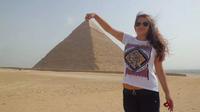Giza Pyramids the Great Sphinx and Sakkara Private Day Tour
Cairo, Egypt
Trip Type: Day Trips
Duration: 8 hours
Visit the oldest of the Seven Wonders of the Ancient World, and the only one to remain largely intact - the Great Pyramid of Giza (also known as the Pyramid of Khufu or the Pyramid of Cheops), the largest monolith statue in the world - Great Sphinx of Giza and ancient burial ground in Egypt, serving as the necropolis for the Ancient Egyptian capital, Memphis - Sakkara.
More About This Activity All Day Trips →
Visit the oldest of the Seven Wonders of the Ancient World, and the only one to remain largely intact - the Great Pyramid of Giza (also known as the Pyramid of Khufu or the Pyramid of Cheops), the largest monolith statue in the world - Great Sphinx of Giza and ancient burial ground in Egypt, serving as the necropolis for the Ancient Egyptian capital, Memphis - Sakkara.Whether you stay in Cairo or Giza itself, your guide who greet you at the hotel and transfer to the pyramids. See the three famous pyramids, touch them while your guide tells you all about them. You will have free time to take pictures and rest. There are three known chambers inside the Great Pyramid. The lowest chamber is cut into the bedrock upon which the pyramid was built and was unfinished. The Queen's Chamber and King's Chamber are higher up within the pyramid structure. The main part of the Giza complex is a setting of buildings that included 2 mortuary temples in honor of Khufu, 3 smaller pyramids for Khufu's wives, an even smaller "satellite" pyramid, a raised causeway connecting the two temples, and small mastaba tombs surrounding the pyramid for nobles. Then, you will be transferred to the area with a panoramic view of all the pyramids and you will be able to start your adventure with a camel ride around the area.
After a short drive you will be taken to see the Great Sphinx, where you will have some time to explore the valley temple. This oldest known monumental sculpture is commonly believed to have been built by ancient Egyptians of the Old Kingdom during the reign of the Pharaoh Khafra. Basic facts about The Great Sphinx are still subject to debate, such as when it was built, by whom, and for what purpose. The face of the Sphinx is generally believed to represent the face of the Pharaoh Khafra. It is the largest monolith statue in the world, standing 73.5 meters (241 ft) long, 19.3 meters (63 ft) wide, and 20.22 meters (66.34 ft) high.
Later, you will be transferred to Saqqara. Explore Saqqara with your Egyptologist tour guide. It features numerous pyramids, including the world famous Step pyramid of Djoser, sometimes referred to as the Step Tomb due to its rectangular base, as well as a number of mastabas. Djoser's step pyramid was built during the Third Dynasty. Another 16 Egyptian kings built pyramids at Sakkara, which are now in various states of preservation or dilapidation. High officials added private funeral monuments to this necropolis during the entire pharaonic period. It remained an important complex for non-royal burials and cult ceremonies for more than 3,000 years. After the tour you will stop an a local restaurant in Cairo for lunch. Then, you will be transferred back to you hotel.
After a short drive you will be taken to see the Great Sphinx, where you will have some time to explore the valley temple. This oldest known monumental sculpture is commonly believed to have been built by ancient Egyptians of the Old Kingdom during the reign of the Pharaoh Khafra. Basic facts about The Great Sphinx are still subject to debate, such as when it was built, by whom, and for what purpose. The face of the Sphinx is generally believed to represent the face of the Pharaoh Khafra. It is the largest monolith statue in the world, standing 73.5 meters (241 ft) long, 19.3 meters (63 ft) wide, and 20.22 meters (66.34 ft) high.
Later, you will be transferred to Saqqara. Explore Saqqara with your Egyptologist tour guide. It features numerous pyramids, including the world famous Step pyramid of Djoser, sometimes referred to as the Step Tomb due to its rectangular base, as well as a number of mastabas. Djoser's step pyramid was built during the Third Dynasty. Another 16 Egyptian kings built pyramids at Sakkara, which are now in various states of preservation or dilapidation. High officials added private funeral monuments to this necropolis during the entire pharaonic period. It remained an important complex for non-royal burials and cult ceremonies for more than 3,000 years. After the tour you will stop an a local restaurant in Cairo for lunch. Then, you will be transferred back to you hotel.
« Go Back

